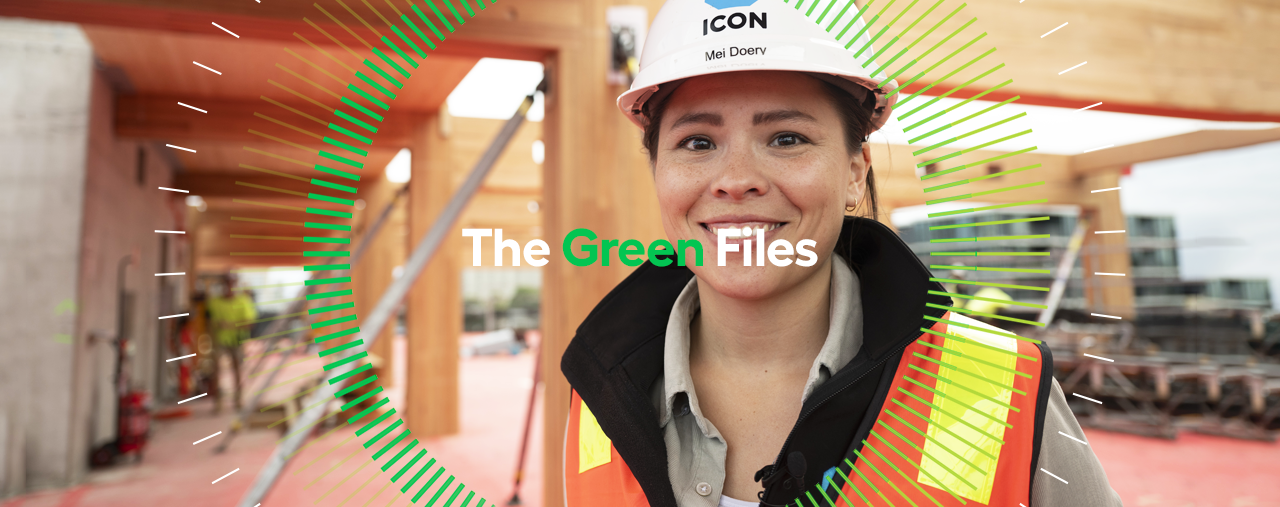
Why timber is the low emissions future for our built environment
The Green Files is a unique CEFC series where we talk to the people making a difference in the race to net zero emissions.
Imagine this. An inner-city construction site that is… quiet. A people-centred design approach that blends the best of technology with the beauty of timber. A finished building where people feel compelled to (literally) feel the structure. And one where lifetime emissions are all headed in one direction: down. Welcome to T3 Collingwood.
Located in the rapidly gentrifying Melbourne fringe suburb of Collingwood, at 15-storeys T3 Collingwood is Melbourne’s tallest mass timber office building. T3 buildings boast an innovative development approach created by specialist global real estate group Hines. It brings together the critical elements of timber, transit, and technology to create sustainable buildings of the future.
As one of just 26 iconic T3 buildings worldwide, the premium-grade T3 Collingwood office tower is an Australian-first showcase of the ‘back to the future’ low carbon benefits of building with timber instead of concrete and steel. The outstanding emissions benefits saw T3 Collingwood win investment support from Australia’s ‘green bank’, via the specialist CEFC Timber Building Financing Program.
T3 Collingwood project manager Mei Doery was responsible for leading this project on behalf of builder ICON. Here Mei explains what it was like to work on such an innovative construction project, and why she thinks more developers will be looking at mass timber construction options.
I think this project set a new benchmark for mass timber buildings, and the industry engagement was enormous, from international institutions, business, universities and the like. I've never had a job that people have been this engaged with.Mei DoeryT3 Collingwood Project Manager
Why is it important to reduce embodied carbon in buildings – that is, the greenhouse gas emissions associated with the materials, construction, maintenance, and eventual demolition of a building?
Buildings are responsible for 39 per cent of global energy related carbon emissions – 28 per cent from operational emissions such as heating, cooling, and powering buildings, and the remaining 11 per cent from embodied emissions. Reducing our carbon is paramount for us in the property and construction industry, and I think recently we’ve done really well in reducing operational emissions. However, those embodied carbon emissions remain relatively unaddressed. This is where I believe our opportunity for carbon reduction lies as builders.
What is mass engineered timber, and why should it be used as an alternative to traditional building materials?
Mass engineered timber is a building material comprised of engineered wood products with improved structural integrity.
Timber literally absorbs carbon out of the atmosphere unlike nearly every other construction material we use. It can also encourage reforestation in a really sustainable way, as it fuels ongoing supply and demand. As long as it's been responsibly and sustainably sourced, we consume more timber, we plant more trees and they absorb more carbon, which is also a win.
Biophilic design – connecting people to the natural world within the built environment – is inherent in timber buildings. I watch people walk around site and go up to the timber and put their hand on it. I don't think I've ever seen anyone do that with concrete.
What were the advantages of building T3 with timber?
Mass timber building materials lend themselves to prefabrication with majority of the works completed offsite, resulting in less people and less moving parts onsite.Instead of 54 concrete and form workers, we had around 14 to 18 timber installers. And this site is less busy, so it was less disruptive to the residents, less noise, less traffic, and there's no finishing late at night.
When it comes to accuracy, you're making the timber in an offsite, controlled environment with accurate machining, so there's less room for human error and onsite errors. And in terms of the timber, apart from one panel needing to be turned over, we didn't have any onsite adjustments or rework to the timber.
What was really lovely from a construction perspective was how motivated everyone was for the project to be successful. A lot of people wanted to be part of the project and build their experience in this space.
Can you tell us about the emissions profile of the T3 Collingwood site, and what made the project a success?
We achieved a 34 per cent embodied carbon reduction against the benchmark building. At the end of the day, you've still got all the materials getting to site, and all the materials being manufactured. So there's always going to be some emissions. But by using timber, you have the ability to offset as well.
We hit all the targets around financial, program delivery and quality, and it's a high performing, renewable development. The intent was to bring this building to the Australian market for a positive change, and that in itself is success.
I think this project set a new benchmark for mass timber buildings, and the industry engagement was enormous, from international institutions, business, universities and the like. I've never had a job that people have been this engaged with.
It also demonstrated what can be achieved when collaborating between different stakeholders who are motivated by the same goal. It wasn't just about making money for everyone. We all had the intent of setting an example of positive change for the construction industry. The industry will never really gain momentum if only a few are working with timber. We need to uplift the market together, which will increase the demand and improve the supply chain offering, expertise and opportunity.
What is the future of timber buildings?
Now that we've set a new precedent for mass timber at this scale and height, I think we'll see more hybrid systems and composites with timber, concrete and steel together.
T3 Collingwood had a large portion made from timber and we achieved 34 per cent emission reduction. So obviously timber goes a long way, but it’s not the only thing.
Part of the City of Melbourne Net Zero 2040 target involves retrofitting on average 80 buildings a year, to achieve a minimum 5-star NABERS energy rating. Rather than demolishing an old building and building new, by retrofitting with timber, you can also drive further emissions benefits by saving a lot on that embodied carbon as well.
What’s going to help us get more timber buildings?
It's a collective effort. We all need to be doing it. We need to be more open to sharing our experiences, the good and especially the bad, so we can all learn and think better.




